by Bruce Wells | Jun 9, 2025 | This Week in Petroleum History
June 9, 1894 – Water Well finds Oil in Corsicana, Texas –
A contractor hired by the town of Corsicana to drill a water well on 12th Street found oil instead, launching the Texas petroleum industry seven years before the more famous Spindletop Hill gusher hundreds of miles to the southeast. Corsicana’s well produced just 2.5 barrels of oil a day from a depth of 1,035 feet, but inspired a rush of exploration companies.

A colorized postcard depicts the Corsicana oilfield circa 1910. The boom town, which became an oilfield service and manufacturing center, today annually celebrates its oil patch heritage.
By 1898, about 300 produced oil in and around the boom town, which also became a center for technological innovation. A Corsicana company patented and manufactured the rotary rig that drilled the 1901 Spindletop discovery well near Beaumont.
Despite Corsicana’s oilfield discovery well bringing petroleum riches and a drilling boom, city officials paid the contractor only half of the $1,000 fee, citing the agreement for completing a water well. Corsicana has hosted an annual Derrick Days since 1976.
Learn more in First Texas Oil Boom.
June 9, 2023 — California Pump Jack added to Historic Register
An eccentric-wheel oilfield pumping unit that operated in California’s largest oilfield joined the National Register of Historic Places, thanks to research by Mark Smith, who submitted the application. Installed by the Engineers Oil Company in 1913, the Kern County jack plant’s eccentric wheels pumped oil until 1990.
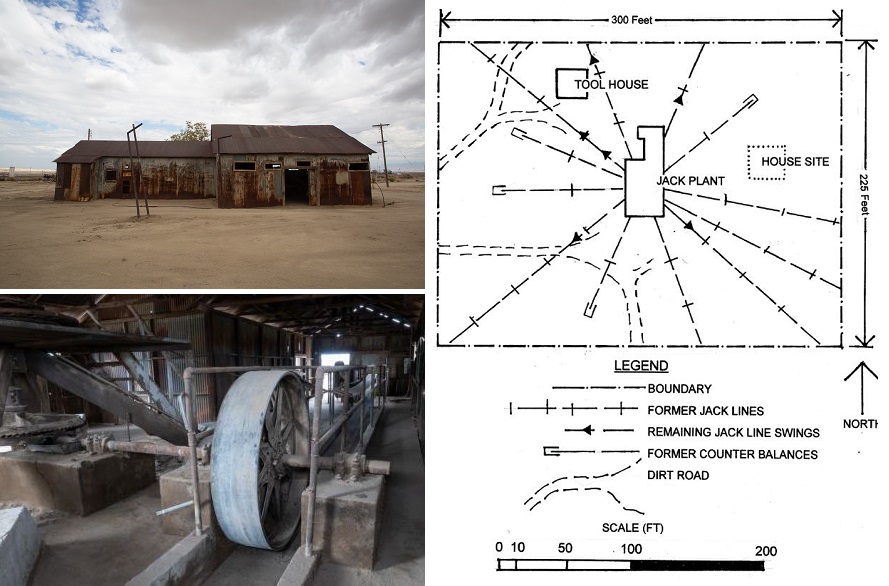
In operation until 1990, California’s Midway-Sunset Jack Plant used eccentric-wheel technologies from the late 19th century. The Kern County plant pumped more than 1.5 million barrels of oil. Photos courtesy John Harte. Illustration courtesy San Joaquin Geological Society.
“The Midway-Sunset Jack Plant is an extremely rare example of central power and ‘jack-line’ oil pumping technology on its original site and housed in its original building,” Smith noted in his 45-page draft application to the State Historical Resources Commission and later approved by the National Park Service. “Its design and operational history reflect significant advancements in oil extraction technology.”

June 11, 1816 – Manufactured Gas lights Art Museum in Baltimore
The first commercial gas lighting of residences, streets and businesses began when Rembrandt Peale impressed Baltimore civic leaders by illuminating a room in his Holliday Street Museum by burning “manufactured gas.” His display (using gas distilled from coal, tar or wood) dazzled them with a “ring beset with gems of light.”

Lighted with manufactured gas, this Baltimore museum opened in 1814, America’s first building erected as a museum. Photo courtesy Maryland Historical Trust.
The Baltimore museum became the first U.S. public building to use gas lighting, according to the Maryland Historical Trust. Within a week, the city council approved plans to illuminate the city’s streets. Peale and a group of investors founded the Gas Light Company of Baltimore — the first gas company in America (today Baltimore Gas and Electric).
Learn more about “town gas” in Illuminating Gaslight.
June 11, 1911 – E.W. Marland discovers Ponca Nation Oilfield
Ernest W. Marland, founder of the 101 Ranch Oil Company in 1908, discovered an oilfield near Ponca City, Oklahoma, after reorganizing the company in his hometown of Pittsburgh, Pennsylvania. Almost broke after drilling eight uneconomical wells, Marland had turned to childhood friend John McCaskey of Pittsburgh, known as the “Sauerkraut King.”

Circa 1910 newspaper promotion of the 101 Ranch Oil Company following discoveries near Ponca (City), west of Osage Nation leases and oilfields.
Partnered with McCaskey and the owners of the 101 Ranch, Marland received permission from White Eagle, chief of the Ponca Nation, to drill near a reservation burial ground. The oilfield discovery well and many that followed produced oil on a reservation allotment owned by Willie-Cries-For-War, age 19, who had leased his 160 acres to Marland for $1,000 a year and 12.5 cents a barrel of oil produced.
Marland would found Marland Oil Company in 1917, merge it with Continental Oil in 1928, and become governor of Oklahoma in 1935. ConocoPhillips opened a Conoco Museum in Ponca City in 2007.
June 11, 1929 – Independent Producers get Organized
Ninety-five years ago, Wirt Franklin of Ardmore, Oklahoma, spoke on behalf of small exploration and production companies during President Herbert Hoover’s Oil Conservation Conference at the Broadmoor Hotel in Colorado Springs, Colorado. Franklin and other independent producers opposed creating a federal commission that could restrict production and allow more imported foreign oil.
“If this condition should be brought about, it would mean the annihilation and destruction of the small producer of crude oil, ” proclaimed Franklin, who had found success in the shallow but prolific Healdton oilfield. Before returning to Ardmore, Franklin and other independents established today’s Washington, D.C.-based Independent Petroleum Association of America (IPAA).

June 12, 1879 – Allegheny Oilfield discovered by O.P. Taylor
Orville “O.P.” Taylor completed the Triangle No. 1 well at a depth of 1,177 feet in Allegheny County, New York, revealing an oilfield that extended into Pennsylvania. His discovery came after two failed wells drilled near oil seeps first reported by a French missionary in 1627. O.P.’s Allegheny oilfield launched a drilling boom that created the town of Petrolia.
The Confederate Army veteran had worked in the cigar manufacturing business in Virginia before catching “oil fever” after reading of oil discoveries along the Allegheny River (see Derricks of Triumph Hill). Early success led to his election as mayor of Wellsville, New York, and the title of “Father of the Allegheny Oilfield.” A Liberty Ship would be named for him during World War II.
June 13, 1917 – Phillips Petroleum Company founded
During the early months of America’s entry into World War I, as oil prices rose above $1 per barrel, Phillips Petroleum Company was founded in Bartlesville, Oklahoma. Brothers Frank and Lee Eldas “L.E.” Phillips consolidated their oil companies and began operating throughout Oklahoma and Kansas. Assets rose from $3 million to $100 million within a few years.
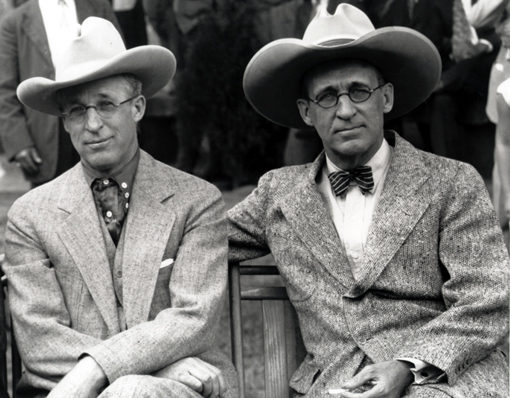
Brothers L.E. Phillips (left) and Frank Phillips established Phillips Petroleum Company in Bartlesville in 1917. Photo courtesy ConocoPhillips.
In 1927, Phillips Petroleum began selling its gasoline in Wichita, Kansas, the first of more than 10,000 Phillips 66 service stations. Phillips chemists received thousands of U.S. patents, including one in 1954 for Marlex, a high-density polyethylene. Wham-O toy company was the first to buy the new plastic (see Petroleum Product Hoopla). The oil company’s high-octane Nu-Aviation fuel played an important role in winning World War II.
Phillips Petroleum merged with Conoco in 2002 to become ConocoPhillips, which in 2007 established petroleum museums in Ponca City and Bartlesville as part of the 100th anniversary of Oklahoma statehood.
June 13, 1928 – Hobbs Oilfield discovered in New Mexico
The New Mexico petroleum industry was launched with the discovery of the Hobbs oilfield near the southeastern corner of the state. After months of difficult cable-tool drilling, the Midwest State No. 1 well produced oil for the Midwest Refining Company, which had drilled the state’s first oil well in 1922.

A June 1928 oilfield discovery brought many decades of petroleum prosperity to downtown Hobbs, New Mexico.
The Hobbs well revealed a giant field, later cited by the New Mexico Bureau of Mines & Mineral Resources as “the most important single discovery of oil in New Mexico’s history.” But after months of drilling, the well had reached a depth of 1,500 feet when an engine house fire consumed the wooden derrick. “Men with less vision would have given up, but not the drillers of Midwest,” noted the state geologist.
As the Great Depression approached, oil production from the Hobbs field attracted investors and drilling companies, quickly transforming Hobbs from “sand, mesquite, bear grass and jackrabbits” to the fastest-growing town in the nation.
Learn more in First New Mexico Oil Wells.

June 14, 1865 – First Daily Oil Region Newspaper
Pennsylvania’s oil region got its first daily newspaper when brothers William and Henry Bloss published a four-page broadsheet, which exceeded a circulation of 300 as the Titusville Herald. The first edition’s articles included a reference to John Wilkes Booth’s visits to the region and his August 1864 oil interests.

The “First Daily Newspaper in the Pennsylvania Oil Region” noted John Wilkes Booth’s petroleum interests.
“John Wilkes Booth purchased a one-thirteenth interest in the territory in August 1864,” the newspaper reported. “We are credibly informed that this Homestead well (see Dramatic Oil Company) in which Booth was interested was destroyed by fire on the day he assassinated President Lincoln.”
June 14, 1938 – United States regulates Natural Gas
The federal government for the first time assumed regulatory control of U.S. natural gas sales to limit the growing market power of interstate pipeline companies.
Although the Natural Gas Act of 1938 did not apply to production, gathering or local distribution, it sought to establish “just and reasonable rates” for pipeline company transmission or sales of natural gas in interstate commerce. Regulatory functions were assigned to the Federal Power Commission (established in 1920), which became the Federal Energy Regulatory Commission (FERC) in 1977.
June 15, 1954 – Launch of First Mobile Offshore Rig
The offshore barge oil drilling platform, Mr. Charlie left its Louisiana shipyard and went to work for Shell Oil Company in a new oilfield in East Bay, near the mouth of the Mississippi River. The vessel’s design, which would revolutionize the offshore industry, originated with Alden “Doc” Laborde, a marine superintendent for the Kerr-McGee Company in Morgan City, Louisiana.
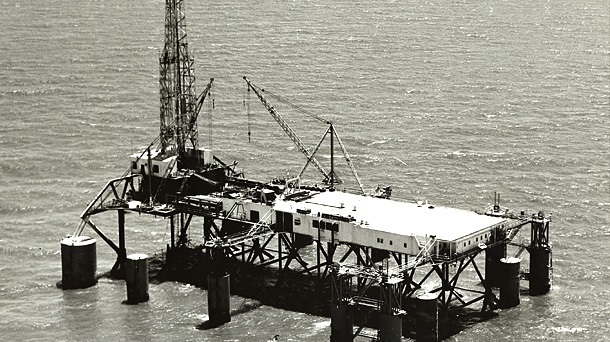
Beginning in 1954 and capable of drilling wells in water up to 40 feet in depth, Mr. Charlie became the first mobile offshore drilling unit (MODU). Photos courtesy Murphy Oil Corp.
Despite Kerr-McGee’s experience with many post-World War II offshore technologies, including drilling the first oil well out of sight of land in 1947, the company decided against Laborde’s idea for a transportable, submersible drilling barge. The inventor, a Navy veteran, eventually found support from Charles Murphy Jr., founder of Murphy Oil Company.

A self-sufficient drilling rig on a barge, Mr. Charlie in 1954 became an offshore technology milestone with its transportable, column-stabilized design.
LaBorde established Ocean Drilling & Exploration and contracted with J. Ray McDermott Company to convert a 220-foot barge into a drilling platform — the world’s first mobile offshore drilling unit (MODU). Today moored in Morgan City as an international petroleum museum, in December 2024 the Secretary of the Interior added Mr. Charlie to the National Register of Historic Places.
Learn more in Mr. Charlie, First Mobile Offshore Drilling Rig.
_______________________
Recommended Reading: Corsicana (2010); Texas Oil and Gas Postcard History (2013); Black Gold in California: The Story of California Petroleum Industry  (2016); In Pursuit of Fame: Rembrandt Peale, 1778-1860 (1993); The Extraction State, A History of Natural Gas in America (2021); Oil And Gas In Oklahoma: Petroleum Geology In Oklahoma
(2016); In Pursuit of Fame: Rembrandt Peale, 1778-1860 (1993); The Extraction State, A History of Natural Gas in America (2021); Oil And Gas In Oklahoma: Petroleum Geology In Oklahoma (2013); Oil Man: The Story of Frank Phillips and the Birth of Phillips Petroleum
(2013); Oil Man: The Story of Frank Phillips and the Birth of Phillips Petroleum (2014); Oil in West Texas and New Mexico
(2014); Oil in West Texas and New Mexico (1982); Around Titusville, Pa., Images of America
(1982); Around Titusville, Pa., Images of America (2004); Offshore Pioneers: Brown & Root and the History of Offshore Oil and Gas
(2004); Offshore Pioneers: Brown & Root and the History of Offshore Oil and Gas (2011); Breaking the Gas Ceiling: Women in the Offshore Oil and Gas Industry (2019);. Your Amazon purchase benefits the American Oil & Gas Historical Society. As an Amazon Associate, AOGHS earns a commission from qualifying purchases.
(2011); Breaking the Gas Ceiling: Women in the Offshore Oil and Gas Industry (2019);. Your Amazon purchase benefits the American Oil & Gas Historical Society. As an Amazon Associate, AOGHS earns a commission from qualifying purchases.
_______________________
The American Oil & Gas Historical Society (AOGHS) preserves U.S. petroleum history. Please become an AOGHS annual supporter and help maintain this energy education website and expand historical research. For more information, contact bawells@aoghs.org. Copyright © 2025 Bruce A. Wells. All rights reserved.
by Bruce Wells | Jun 2, 2025 | This Week in Petroleum History
June 2, 1908 – Goose Creek Oilfield discovered –
Drilled on Galveston Bay wetlands, the first offshore well in Texas revealed a giant oilfield 20 miles southeast of Houston, according to the Texas State Historical Association (TSHA). Inspired by reports of bubbles on the surface where Goose Creek emptied into the bay, the Houston-based syndicate Goose Creek Production Company made the discovery at a depth of 1,600 feet.

A single well of the Goose Creek field in 1917 produced 35,000 barrels of oil a day from a depth of 3,050 feet. Circa 1919 photo by Frank Schlueter courtesy Library of Congress Prints and Photographs Division.
“Within days the syndicate sold out to a subsidiary of the Texas Company, the future Texaco,” notes TSHA, adding the Goose Creek field, “spurred exploration for deep-seated (salt) domes, and led to the discovery of some of the largest oilfields in the United States.”
In 1909, Howard Hughes Sr. secretly tested an experimental dual-cone rock bit at Goose Creek. Humble Oil and Refining Company constructed a refinery adjacent to the field In 1921, naming the site Baytown.
June 3, 1979 – Bay of Campeche Oil Spill
Drilling in about 150 feet of water, the semi-submersible platform Sedco 135 suffered a blowout 50 miles off Mexico’s Gulf Coast. The Pemex well Ixtoc 1 spilled 3.4 million barrels of oil before being controlled nine months later. Considering the spill’s size, the environmental impact proved less than expected, according to a 1981 report by the Coordinated Program of Ecological Studies in the Bay of Campeche. Surveys of Campeche Sound conducted in 1980 reported, “Evaporation, dispersion, photo-oxidation and biodegradation processes played a major role in attenuating the harmful environmental effects of the oil spill.”
June 4, 1872 – Pennsylvania Oilfields bring Petroleum Jelly
A young chemist living in New York City, Robert Chesebrough, patented “a new and useful product from petroleum,” which he named “Vaseline.” His patent proclaimed the virtues of this purified extract of petroleum distillation residue as a lubricant, hair treatment, and balm for chapped hands.
patented “a new and useful product from petroleum,” which he named “Vaseline.” His patent proclaimed the virtues of this purified extract of petroleum distillation residue as a lubricant, hair treatment, and balm for chapped hands.
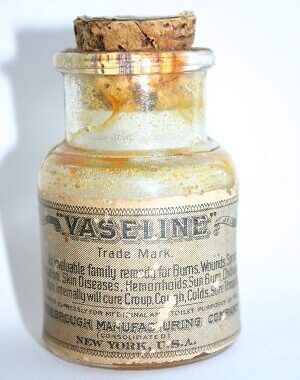
Robert Chesebrough consumed a spoonful of Vaseline each day and lived to be 96 years old. Photo courtesy Drake Well Museum.
When the 22-year-old chemist visited the new Pennsylvania oilfields in 1865, he noted drilling was often confounded by a paraffin-like substance that clogged the wellhead. Drillers used the “rod wax” as a quick first aid for abrasions.
Chesebrough returned to New York City and worked in his laboratory to purify the well byproduct, which he first called “petroleum jelly.” Female customers would discover that mixing lamp black with Vaseline made an impromptu mascara. In 1913, Mabel Williams employed just such a concoction and it led to the founding of a cosmetic company.
Learn more in The Crude History of Mabel’s Eyelashes.

June 4, 1892 – Devastation of Pennsylvania Oil Regions
After weeks of thunderstorms in Pennsylvania’s Oil Creek Valley, the Spartansburg Dam on Oil Creek burst, sending torrents of water that killed more than 100 people and destroyed homes and businesses in Titusville and Oil City. The disaster was compounded when fires broke out.
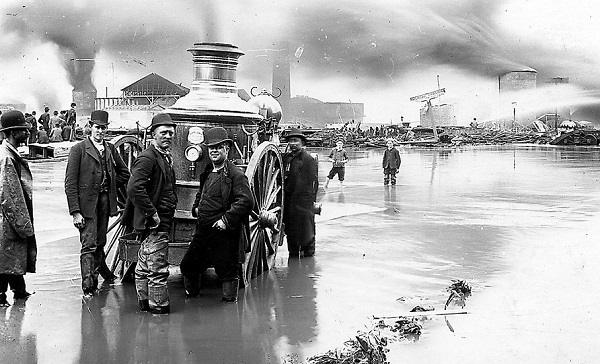
Titusville, Pennsylvania, residents used the “Colonel Drake Steam Pumper” during the great flood and fire of 1892. Photo by John Mather courtesy Drake Well Museum and Park.
“This city during the past twenty-four hours has been visited by one of the most appalling fires and overwhelming floods in the history of this country,” reported the New York Times from Oil City. Oilfield photographer John A. Mather documented the devastation, which included his Titusville studio and 16,000 glass-plate negatives.
Learn more in Oilfield photographer John Mather.
June 4, 1896 – Henry Ford drives his “Quadricycle”
Driving the first car he ever built, Henry Ford left a workshop behind his home on Bagley Avenue in Detroit, Michigan. He had designed his “Quadricycle” in his spare time while working as an engineer for Edison Illuminating Company. Ford chose the name because his handmade, 500-pound “horseless carriage” ran on four bicycle tires. Inspired by advancements in gasoline-fueled engines, he founded the Henry Ford Company in 1903.
June 4, 1921 – Petroleum Seismograph tested
A team of earth scientists tested an experimental seismograph device on a farm three miles north of Oklahoma City and determined it could accurately map subsurface structures. Led by Prof. John C. Karcher and W.P. Haseman, the team from the University of Oklahoma found that seismology could be useful for oil and natural gas exploration and production. Further seismic reflection tests, including one in the Arbuckle formation in August, confirmed their results.

June 6, 1932 – First Federal Gasoline Tax
The federal government taxed gasoline for the first time when the Revenue Act of 1932 added a one-cent per gallon excise tax to U.S. gasoline sales. The first state to tax gasoline was Oregon, which imposed a one-cent per gallon tax in 1919. Colorado, New Mexico, and other states followed. The federal tax, last raised on October 1, 1993, has remained at 18.4 cents per gallon (24.4 cents per gallon for diesel). About 60 percent of federal gasoline taxes are used for highway and bridge construction.
June 6, 1944 – English Channel Pipelines fuel WWII Victory
As the D-Day invasion began along 50 miles of fortified French coastline in Normandy, logistics for supplying the effort would include two top-secret engineering feats — the construction of artificial harbors followed by the laying of pipelines across the English Channel.

Operation PLUTO (Pipe Line Under The Ocean) unspooled flexible steel pipelines across the English Channel, but the channel was deep, the French ports distant.
Code-named “Mulberrys” and using a design similar to modern jack-up offshore rigs, the artificial harbors used barges with retractable pylons to provide platforms to support floating causeways extending to the beaches.
To fuel the Allied advance into Nazi Germany, Operation PLUTO (Pipe Line Under The Ocean) used flexible steel pipelines wound onto giant “conundrums” designed to spool off when towed. Gen. Dwight Eisenhower later acknowledged the vital importance of the oil pipelines.
Learn more in PLUTO, Secret Pipelines of WW II.
June 6, 1976 – Oil Billionaire J. Paul Getty dies
With a fortune reaching $6 billion (about $32 billion in 2023), J. Paul Getty died at 83 at his estate near London. Born into his father’s petroleum wealth from the Oil Company of Tulsa, Getty made his first million by age 23 from buying and selling oil leases.

The J. Paul Getty Museum art collection is housed in the Getty Center (above) and the Getty Villa on the California Malibu coast.
“I started in September 1914, to buy leases in the so-called red-beds area of Oklahoma,” Getty once told the New York Times. “The surface was red dirt and it was considered impossible there was any oil there. My father and I did not agree and we got many leases for very little money which later turned out to be rich leases.”
Getty, who incorporated Getty Oil in 1942, gave more than $660 million from his estate to the J. Paul Getty Museum.
______________________
Recommended Reading: History Of Oil Well Drilling (2007); Western Pennsylvania’s Oil Heritage
(2007); Western Pennsylvania’s Oil Heritage (2008); The Maybelline Story: And the Spirited Family Dynasty Behind It
(2008); The Maybelline Story: And the Spirited Family Dynasty Behind It (2010); Around Titusville, Pennsylvania, Images of America
(2010); Around Titusville, Pennsylvania, Images of America (2004); I Invented the Modern Age: The Rise of Henry Ford
(2004); I Invented the Modern Age: The Rise of Henry Ford (2014); Trek of the Oil Finders: A History of Exploration for Petroleum (1975); Code Name MULBERRY: The Planning Building and Operation of the Normandy Harbours
(2014); Trek of the Oil Finders: A History of Exploration for Petroleum (1975); Code Name MULBERRY: The Planning Building and Operation of the Normandy Harbours (1977); The Great Getty (1986). Your Amazon purchase benefits the American Oil & Gas Historical Society. As an Amazon Associate, AOGHS earns a commission from qualifying purchases.
(1977); The Great Getty (1986). Your Amazon purchase benefits the American Oil & Gas Historical Society. As an Amazon Associate, AOGHS earns a commission from qualifying purchases.
_______________________
The American Oil & Gas Historical Society (AOGHS) preserves U.S. petroleum history. Please become an AOGHS annual supporter and help maintain this energy education website and expand historical research. For more information, contact bawells@aoghs.org. © 2025 Bruce A. Wells. All rights reserved.
by Bruce Wells | May 26, 2025 | This Week in Petroleum History
May 26, 1891 – Carbon Black Patent leads to Crayola –
Edwin Binney and C. Harold Smith received a patent for an “Apparatus for the Manufacture of Carbon Black.” The Binney & Smith process created a fine, intensely black soot-like substance — a pigment blacker than any other. Its success would lead to another petroleum product, Crayola crayons.
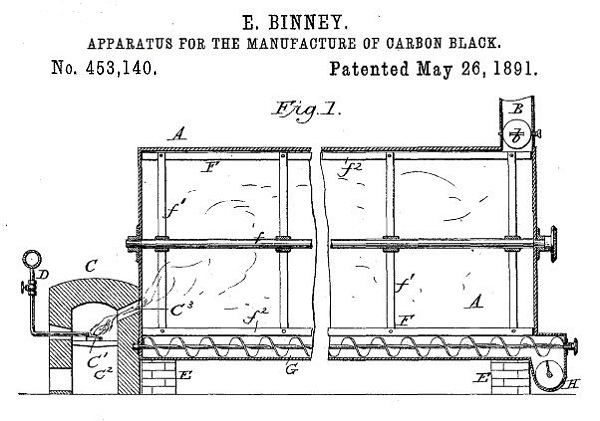
Edwin Binney in 1891 patented a petroleum-burning “Apparatus for the Manufacture of Carbon Black.” Twelve years later, Binney & Smith produced another oilfield product, Crayola, named by his wife Alice.
After introducing a popular black crayon called Staonal (stay-on-all) the Pennsylvania company began manufacturing Crayola crayons in 1903 using paraffin hand-mixed pigments. Each box contained eight colors: red, orange, yellow, green, blue, violet, brown and black.
Learn more in Carbon Black and Oilfield Crayons. (more…)
by Bruce Wells | May 19, 2025 | This Week in Petroleum History
May 19, 1885 – Lima Oilfield discovered in Ohio –
Ohio’s petroleum industry began when Benjamin Faurot found oil at Lima in the northwestern part of the state. He had been searching for natural gas in the prolific Trenton Rock Limestone (see Indiana Natural Gas Boom). “If the well turns out, as it looks now that it will, look out for the biggest boom Lima ever had,” proclaimed Lima’s Daily Republican newspaper.
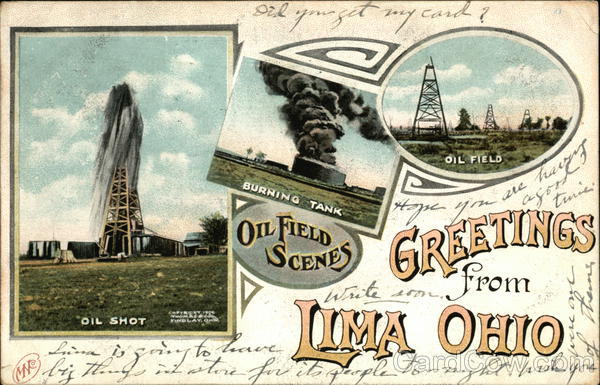
A 1919 postcard published by Robbins Bros., Boston, promotes the oil wealth of Lima, Ohio, with derricks, an oil gusher, and a burning oil tank.
Faurot organized the Trenton Rock Oil Company, and by 1886 the Lima oilfield was producing more than 20 million barrels of oil, the most in the nation. The Lima field’s heavy oil needed special refining, and Standard Oil Company of New Jersey in 1889 began construction on the Whiting refinery.
Learn more in Great Oil Boom of Lima, Ohio.
May 19, 1942 – Oklahoma Inventor patents Portable Drilling Rig
A pioneer in oilfield technologies, George E. Failing of Enid, Oklahoma, received a patent for his design of a drilling rig on a truck bed. “I designate the rear portion of a drilling rig such as used in drilling shallow wells, the taking of cores, drilling of shot-holes, and performing similar oil field operations,” Failing noted in his patent.
In 1931, he had mounted a rig on a 1927 Ford farm truck, “adding a power take-off assembly to transfer power from the truck engine to the drill,” according to the Oklahoma Historical Society. Failing would receive more than 300 patents for oilfield tools, “from rock bit cores to an apparatus for seismic surveying.”

George Failing’s rig design — powered by a pickup truck’s engine — proved ideal for rapidly drilling slanted wells.
Failing’s portable rig could drill ten slanted, 50-foot holes in a single day, while a traditional rotary rig took about a week to set up and drill to a similar depth. He demonstrated his portable drilling technology at a 1933 well disaster in Conroe, Texas, working with H. John Eastman, today considered the father of directional drilling (see Technology and the “Conroe Crater”).

May 19, 1969 – First Offshore Technology Conference
Houston’s largest convention and tradeshow, the Offshore Technology Conference, began in response to “growing technological needs of the global ocean extraction and environmental protection industries,” according to History of OTC. In 2013, more than 2,700 companies exhibited in “an area equivalent to 10 U.S. football fields.”

Since 1969, the conference has generated more than $3.2 billion for Houston. OTC Brasil was launched in 2011 along with an Arctic Technology Conference (2011-2016). OTC Asia was launched in 2012. The next Houston OTC will take place May 4-7, 2026.
May 20, 1930 – Geophysicists establish Professional Society
Earth scientists in Houston established the Society of Economic Geophysicists to encourage the ethical practice of geophysics in the exploration and development of natural resources. The organization in 1937 adopted the name Society of Exploration Geophysicists (SEG), which in 2024 reported 14,000 members in 114 countries.
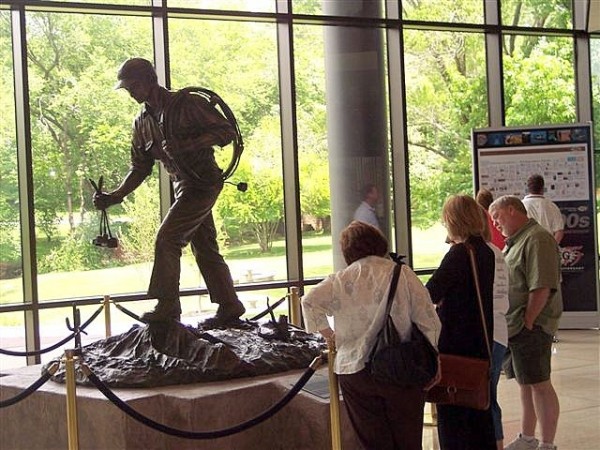
The Doodlebugger by Oklahoma sculptor Jay O’Melia has welcomed visitors to SEG headquarters since 2002. Photo by Bruce Wells.
SEG’s journal Geophysics began publishing in 1936 with articles on exploration technologies, including seismic, gravity, and magnetic imaging. The journal warned of hucksters using vague or unproven properties of oil and geological formations. At its Tulsa headquarters in 2002, SEG unveiled The Doodlebugger, a 10-foot bronze statue by Oklahoma sculptor Jay O’Melia, who also sculpted the Oil Patch Warrior, a World War II memorial.
May 21, 1923 – “Esso” first used by Standard Oil Company
For the first time, Standard Oil Company of New Jersey used “Esso” to market the company’s “refined, semi-refined, and unrefined oils made from petroleum, both with and without admixture of animal, vegetable, or mineral oils, for illuminating, burning, power, fuel, and lubricating purposes, and greases.”

Standard Oil of New Jersey logo, 1923 to 1934, when text became plainer and inside an ellipse.
In 1923, Esso — the phonetic spelling of the abbreviation “S.O.” for Standard Oil — became a registered trademark. The future children’s book author Theodor Geisel — Dr. Seuss — began drawing Essolube product ads in the 1930s. Exxon (now ExxonMobil) removed its U.S. Esso brand in 1973.
May 23, 1905 – Patent issued for Improved Metal Barrel Lid
Henry Wehrhahn, superintendent for the Iron Clad Manufacturing Company of Brooklyn, New York, received the first of two 1905 patents that presaged the modern 55-gallon oil drum. The first design included “a means for readily detaching and securing the head of a metal barrel.”
Wehrhahn assigned his patent rights to the widow of Robert Seaman, founder of Iron Clad Manufacturing, Elizabeth Cochrane Seaman — journalist Nellie Bly. In December 1905, Wehrhahn also assigned her the rights to his improved metal barrel patent.
Learn more in Remarkable Nellie Bly’s Oil Drum.

May 23, 1937 – Death of World’s Richest Man
Almost 70 years after founding Standard Oil Company in Ohio and 40 years after retiring from the company in 1897, John D. Rockefeller died in Ormond Beach, Florida, at age 97. His petroleum empire had peaked in 1912.
Born on July 8, 1839, in Richford, New York, Rockefeller attended high school in Cleveland, Ohio, from 1853 to 1855. He became an assistant bookkeeper with a produce shipping company before forming his own company in 1859 — the same year of the first U.S. oil well in Pennsylvania. Rockefeller was 24 in 1865 when he took control of his first refinery, which would be the largest in the world three years later.

John Rockefeller, 1839-1937. Photo courtesy of Cleveland State University.
By the time his petroleum fortune peaked at $900 million in 1912 ($29.7 billion in 2025 dollars), Rockefeller’s philanthropy was well known. His unprecedented wealth funded the University of Chicago, the Rockefeller Institute for Medical Research, (now the Rockefeller Foundation), and Spelman College in Atlanta.
May 24, 1902 – Oil & Gas Journal published
Holland Reavis founded the Oil Investors’ Journal In Beaumont, Texas, to report on financial issues facing operators and investors in the giant oilfield discovered nearby one year earlier at Spindletop Hill. Reavis sold his semimonthly publication to Patrick Boyle of Oil City, Pennsylvania, in 1910.

Norman Rockwell illustrated a 1962 ad promoting the Oil and Gas Journal.
Boyle, a former oilfield scout and publisher of the Oil City Derrick, increased publication frequency to weekly and renamed it the Oil & Gas Journal. Following his death in 1920, son-in-law Frank Lauinger moved operations to Tulsa and further expanded the company, which became PennWell Publishing in 1980. The Derrick newspaper in Oil City, which began in 1885, continues to be published by the Boyle family.

May 24, 1920 – Huntington Beach Oilfield discovered in California
A Standard Oil Company of California exploratory well discovered the Huntington Beach oilfield. The beach town’s population grew from 1,500 to 5,000 within a month of the well drilled at Clay Avenue and Golden West Street.

A forest of derricks crowd the Huntington Beach in 1926. The giant oilfield produced more than 16 million barrels of oil in 1964 alone and totaled more than one billion barrels by 2000. Photo courtesy Orange County Archives.
The field had 59 producing wells with daily production of 16,500 barrels of oil by November 1921. The activity brought national attention to Huntington Beach and renewed interest in the Los Angeles City oilfield.
By 2000, the giant oilfield had produced more than one billion barrels of oil, according to the Orange County Register, which noted that as production peaked, “the pressure of explosive population growth began pushing the wells off land that had become more valuable as sites for housing.”
_______________________
Recommended Reading: Ohio Oil and Gas (2008); History Of Oil Well Drilling (2007); Careers in Geophysics
(2007); Careers in Geophysics (2017); Offshore Pioneers: Brown & Root and the History of Offshore Oil and Gas
(2017); Offshore Pioneers: Brown & Root and the History of Offshore Oil and Gas (1997); A Geophysicist’s Memoir: Searching for Oil on Six Continents
(1997); A Geophysicist’s Memoir: Searching for Oil on Six Continents (2017); Nellie Bly: Daredevil, Reporter, Feminist
(2017); Nellie Bly: Daredevil, Reporter, Feminist (1994); Titan: The Life of John D. Rockefeller, Sr.
(1994); Titan: The Life of John D. Rockefeller, Sr. (2004); Giant Under the Hill: A History of the Spindletop Oil Discovery
(2004); Giant Under the Hill: A History of the Spindletop Oil Discovery (2008); Huntington Beach, California, Postcard History Series
(2008); Huntington Beach, California, Postcard History Series (2009). Your Amazon purchase benefits the American Oil & Gas Historical Society. As an Amazon Associate, AOGHS earns a commission from qualifying purchases.
(2009). Your Amazon purchase benefits the American Oil & Gas Historical Society. As an Amazon Associate, AOGHS earns a commission from qualifying purchases.
_______________________
The American Oil & Gas Historical Society preserves U.S. petroleum history. Please become an annual AOGHS supporter and help maintain this energy education website and expand historical research. For more information, contact bawells@aoghs.org. Copyright © 2025 Bruce A. Wells. All rights reserved.
by Bruce Wells | May 12, 2025 | This Week in Petroleum History
May 12, 2007 – Oil Museums open in Oklahoma –
ConocoPhillips opened two petroleum museums as part of the 2007 Oklahoma statehood centennial celebrations (see ConocoPhillips Petroleum Museums). The company reportedly spent $10 million on state-of-the-art museums in Bartlesville and Ponca City.
Conoco began in the 1880s as the Continental Oil Company, a grease and kerosene distributor in Utah, before merging with Ponca City-based Marland Oil Company in 1929. Conoco merged with Phillips Petroleum Company of Bartlesville in 2002. (more…)
by Bruce Wells | May 5, 2025 | This Week in Petroleum History
May 5, 1889 – Construction begins on Giant Refinery –
On the southern shore of Lake Michigan near Chicago, Standard Oil Company of New Jersey began construction of its 235-acre refinery complex with advanced processing technologies. A newly patented refining method would allow the Whiting, Indiana, facility to process sulfurous “sour crude” from Lima, Ohio, oilfields.

Standard Oil of Indiana emerged as an independent company following the 1911 breakup of the Standard Oil Trust.
The refinery would be operated by a new subsidiary established in June, Standard Oil Company of Indiana. The Whiting refinery (in 2025 operated by BP) originally produced high-quality kerosene for lamps. BP completed a multi-billion dollar modernization project there in 2013.
Learn more in Standard Oil Whiting Refinery.
May 5, 1907 – A Marker to North Texas Petroleum History
Outside Oil City (today Petrolia), Texas, the Clayco Oil & Pipe Line Company completed its Lochridge No.1 well, “site of the first gas well in Texas,” according to a granite marker that credits local rancher J.W. Lochridge for the discovery east of Wichita Falls.
“This discovery marked the beginning of intensive development of the gas industry in Texas,” the marker explains. Lochridge had been disappointed with a 1901 well that produced some oil, which he used in his dipping vats to rid his cattle of parasites, according to a 2016 article in North Texas Farm & Ranch.
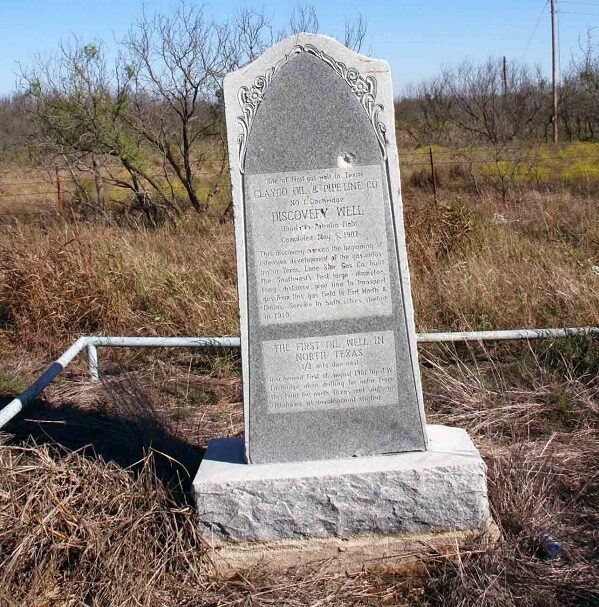
Clayco Oil & Pipe Line Company commemorated its 1907 discovery in North Texas with a marker that has endured near Highway 148 south of Petrolia.
The Clayco Oil & Pipe Line Company marker in the Henrietta-Petrolia field acknowledges Lone Star Gas Company for constructing the state’s first large-diameter natural gas pipeline in 1920 to Fort Worth and Dallas. Lone Star Gas changed its name to Enserch Corporation in 1975.
May 7, 1920 – Halliburton founds Well Cementing Company
As mid-continent oil and gas discoveries continued, Erle Palmer Halliburton founded the Halliburton Company as an oilfield well service and cementing company. The Wilson, Oklahoma, venture succeeded his New Method Oil Cementing Company, established a year earlier during the Burkburnett oil boom in North Texas.

An Erle P. Halliburton statue was dedicated in 1993 in Duncan, Oklahoma.
In 1922, Halliburton patented an innovative “jet-cement” mixer that increased the speed and quality of the mixing process. By the end of the year, 17 Halliburton trucks were cementing wells in Texas, Oklahoma, Louisiana, and Arkansas. Cement injection protects the well casing, seals off water formations from the oil, and minimizes the danger of blowouts.
The company introduced cement pumps powered by truck motors (instead of steam from the rig boiler) and a device that allowed testing of a formation without setting casing. Halliburton was the first to offer self-contained cementing units operating under their own power. More advances in cementing technology followed.
Learn more in Halliburton cements Wells.
May 8, 1918 – Shreveport Gassers go Extra Innings
As baseball became America’s favorite pastime, the Texas League’s Shreveport Gassers played 20 innings against the Fort Worth Panthers before the game was declared a tie. The Gassers were just one of many oilfield-related teams in the National Association of Professional Baseball Leagues, today known as Minor League Baseball.
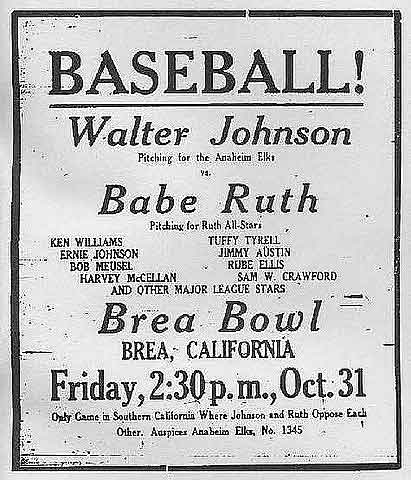
Former Olinda Oil Wells pitcher Walter Johnson joined Babe Ruth for a 1924 exhibition game at Brea, California.
At the time, the leagues’ 96 teams included the Okmulgee Drillers, the Tulsa Oilers, the Independence Producers, the Beaumont Exporters, the Corsicana Oil Citys, the Wichita Falls Spudders, and the Iola Gasbags. In Oklahoma oilfields, the Okmulgee Drillers for the first time in baseball history had two players who combined to hit 100 home runs in a single season of 160 games.
Learn more in Oilfields of Dreams.
May 8, 1920 – Burbank field discovered in Oklahoma
Drilling for natural gas 20 miles east of Ponca City, Oklahoma, the Kay County Gas Company’s Bertha Hickman No. 1 well revealed a giant oilfield. Marland Oil & Refining Company assumed control of the discovery well, which produced 150 barrels of oil a day from a depth of about 3,000 feet. The Burbank field would extend over 33 square miles, mostly in Osage County, and produce between 20 million and 31 million barrels of oil annually for the next four years.
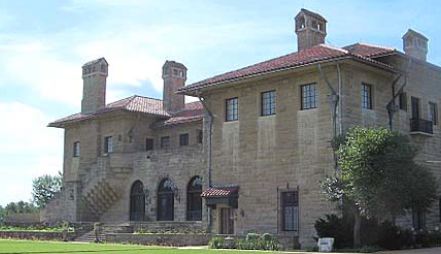
E.W. Marland in 1928 built his Ponca City mansion, now a museum. Fellow Oklahoman Will Rogers was a frequent guest.
With Oklahoma petroleum production booming since the Red Fork Gusher of 1901, independent producers agreed to use a 10-acre well spacing for oil conservation. Ernest W. Marland (Oklahoma governor from 1935 to 1939) applied new seismography technologies to discover the Tonkawa oilfield in June 1921. Visit the Marland Estate in Ponca City.
May 9, 1863 – Confederate Cavalry raids Oilfield
Confederate cavalry attacked a thriving oil town near the Ohio River in what would soon become West Virginia. Confederate Gen. William “Grumble” Jones led the rebel cavalry brigade raid on Burning Springs oilfield storage facilities containing thousands of barrels of oil.
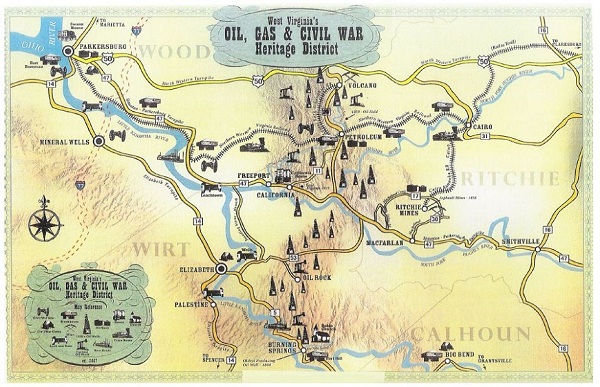
Rebels attacked the Burning Springs oilfield on the banks of the Little Kanawha River, just a few miles southeast of Parkersburg and the Ohio River. Heritage district map courtesy Oil & Gas Museum, Parkersburg, West Virginia.
About 1,300 Confederate troopers raided Burning Springs, destroying cable-tools and burning 150,000 barrels of oil. “All the oil, the tanks, barrels, engines for pumping, engine-houses, and wagons — in a word, everything used for raising, holding, or sending it off was burned,” Gen. Jones reported to Gen. Robert E. Lee. The destruction and fires along the Kanawha River marked the first time an oilfield was targeted in warfare, according to West Virginia historian David McKain.
Learn more in Confederates attack Oilfield.

May 11, 1880 – Dresser patents Oil Well Device
Solomon R. Dresser of Bradford, Pennsylvania, patented a rubber “packer” for sealing downhole pressure in wells. The technology behind the patent (no. 227419) helped confine gas, “which enters the well from the lower rocks and utilizes its force or pressure to expel the oil from the well.”
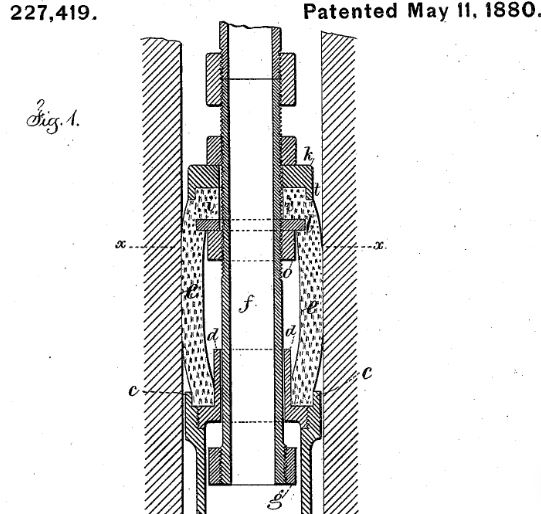
Detail from Solomon R. Dresser 1880 patent for a rubber “packer” to seal downhole pressure in wells.
With the success of his Dresser “Cap Packer” in the giant Bradford oilfield, the inventor founded the S.R. Dresser Manufacturing Company. In 1885, he patented a flexible coupling known as a “Dresser Joint,” a widely adopted pipeline coupling method using rubber for tight seals, which permitted long-range transmission of natural gas.
After expanding into manufacturing oilfield pumps, engines, and compressors, Dresser’s company went public in 1928, moving its headquarters from Bradford to Dallas in 1950. Dresser Industries merged with oilfield supply rival Halliburton for about $7.7 billion in stock in 1998.
Recommended Reading: Erle P. Halliburton, Genius with Cement (1959); Oil in Oklahoma
(1959); Oil in Oklahoma (1976); Textile League Baseball: South Carolina’s Mill Teams, 1880-1955
(1976); Textile League Baseball: South Carolina’s Mill Teams, 1880-1955 (2004); The Civil War and Northwestern Virginia
(2004); The Civil War and Northwestern Virginia (2004); Conoco: 125 Years of Energy
(2004); Conoco: 125 Years of Energy (2000); Phillips, The First 66 Years
(2000); Phillips, The First 66 Years (1983). Your Amazon purchase benefits the American Oil & Gas Historical Society. As an Amazon Associate, AOGHS earns a commission from qualifying purchases.
(1983). Your Amazon purchase benefits the American Oil & Gas Historical Society. As an Amazon Associate, AOGHS earns a commission from qualifying purchases.
_______________________
The American Oil & Gas Historical Society preserves U.S. petroleum history. Please become an AOGHS annual supporter and help maintain this energy education website and expand historical research. Contact bawells@aoghs.org. Copyright © 2025 Bruce A. Wells. All rights reserved.









(2016); In Pursuit of Fame: Rembrandt Peale, 1778-1860 (1993); The Extraction State, A History of Natural Gas in America (2021); Oil And Gas In Oklahoma: Petroleum Geology In Oklahoma
(2013); Oil Man: The Story of Frank Phillips and the Birth of Phillips Petroleum
(2014); Oil in West Texas and New Mexico
(1982); Around Titusville, Pa., Images of America
(2004); Offshore Pioneers: Brown & Root and the History of Offshore Oil and Gas
(2011); Breaking the Gas Ceiling: Women in the Offshore Oil and Gas Industry (2019);. Your Amazon purchase benefits the American Oil & Gas Historical Society. As an Amazon Associate, AOGHS earns a commission from qualifying purchases.

























